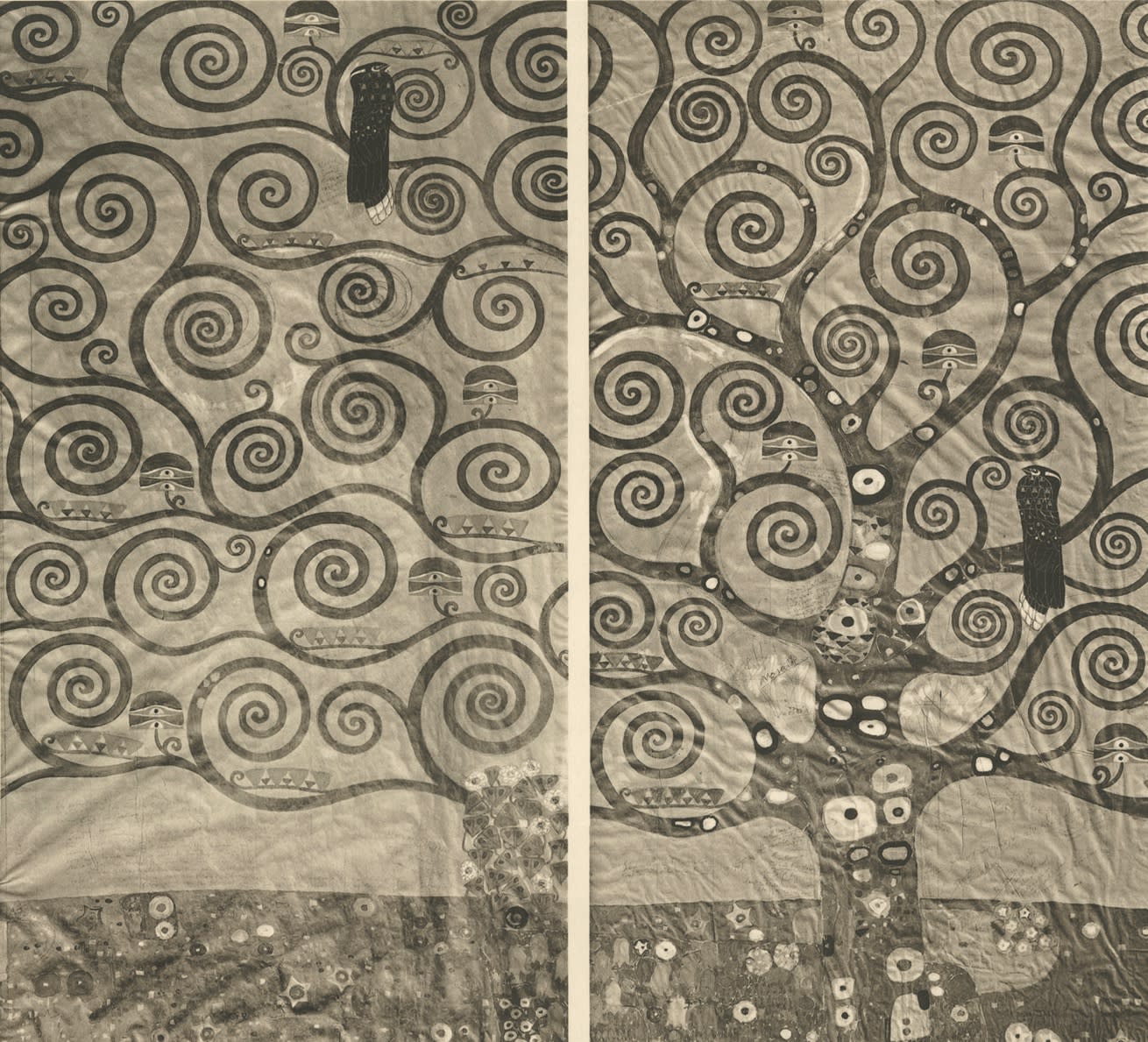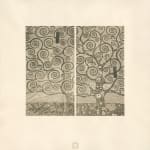Gustav Klimt Austrian, 1862-1918
1931
After Gustav Klimt, Max Eisler Plates #14 Der Lebensbaum (Fortsetzung), aka Tree of Life (Continuation), black & white collotypes after the 1911 cartoon originally in crayon, graphite pencil, gouache and metal powders.
GUSTAV KLIMT EINE NACHLESE (GUSTAV KLIMT AN AFTERMATH), a portfolio of 30 collotypes prints, 15 are multi-color and 15 are monochrome, on chine colle paper laid down on heavy cream-wove paper with deckled edges; Max Eisler, Editor-Publisher; Osterreichischer Staatsdruckerei (Austrian State Printing Office), Printer; in a limited edition of 500 numbered examples of which: 200 were printed in German, 150 were printed in French and 150 were printed in English; Vienna, 1931.
Approximately 25 percent of the original works featured in the Aftermath portfolio have since been lost. Of those 30, six were destroyed by fire on 8 May 1945. On that fateful final day of WWII, the retreating Feldherrnhalle, a tank division of the German Army, set fire to the Schloss Immendorf which was a 16th century castle in Lower Austria used between 1942-1945 to store objects of art. All three of Klimt’s Faculty Paintings: Philosophy, Medicine and Jurisprudence (1900-1907), originally created for the University of Vienna, were on premises at that time. Also among the inventory of Klimt paintings in storage there was art which had been confiscated by the Nazis. One of the most significant confiscated collections was the Lederer collection which featured many works by Gustav Klimt such as Girlfriends II and Garden Path with Chickens. In many instances, Aftermath is our only link to these lost treasures.
Max Eisler (1881-1937), the publisher of the 1931 Aftermath portfolio, was an art historian at Vienna University specializing in modern and contemporary arts and crafts whose 1920 book on Klimt was the first Klimt monograph. He saw An Aftermath as filling-in important gaps left by the earlier print portfolios which had only featured Klimt up to 1913 and which had glossed over major art projects such as the Tree of Life frieze for the Palais Stoclet. And whereas only 10 of the 50 prints from the earlier portfolios published by H.O. Miethke were made in intricate multi-color images, Eisler augmented the earlier format by featuring half of the 30 images in stunning multi-colored collotypes. Understanding the fragile nature of the collotype printing process also reinforces this project’s distinctive and exceptional characteristics. Fragile collotype plates can not be reused. As such, this necessitates the completion of a run on the first go and also dictates a limited production number. Printed by hand, the collotypes required deft handling by the printer, Osterreichische Staatsdruckerei. A complicated and lengthy process involving gelatin colloids mixed with dichromates, the creation of 16 color separation thin glass filters to achieve the light-sensitive internegative images which could faithfully capture all of the painting’s tonal gradations and colors, exposure to actinic light, and delicate chine collie papers which allowed for greater color saturation, the printer’s collaborative role in capturing and transmitting Klimt’s nuanced paint strokes is nothing short of remarkable.
The Österreichische Staatsdruckerei (Austrian State Printing Office), was the successor to the KK Hof -und Staatsdruckerei which was founded by Emperor Franz I in 1804 and whose collotype printing innovations of Klimt’s art was first featured in H.O. Miethke’s Das Werk Gustav Klimts portfolios (1908-1913). By 1931, when Max Eisler published Gustav Klimt: An Aftermath, the printer had undergone the name change but had continued its tradition of state-of-the-art collotype art printing.
These multicolored collotype prints are perfect examples of what Klimt referred to as “major art projects.” The very nature of the print medium brings the artist and audience together in a highly accessible way. Each step in the process of their creation required a high level of technical expertise, innovative thinking and true artistic collaboration, Gesamtkunstwerk.
Ever the collaborator, Klimt was the face and voice of many modernist groups and movements: he was President of the Vienna Secession until the split in 1905 when his faction joined forces with the Wiener Werkstaate; he presided over Kunstschau 1908; and he was a founding member of the Austrian Werkbund. Polarizing at times, Klimt’s ability to stimulate discourse and debate during his own lifetime sheds as much light on his social milieu as it does on Klimt, the artist, and his art.
Klimt’s artistic vision extended beyond the studio; he was particularly interested in overcoming the separation between the artist and the consumer. In an effort to bridge that barrier and move towards true unification of artistic experience, Klimt helped develop pioneering art portfolios. In his speech at the opening of Kunstschau 1908, Klimt privileged the role of anyone who sought a relationship with art and declared that contemplation of an artwork was “an act of creative consumption.” Going so far as to radically redefine what it was to be an artist, Klimt expanded Stilkunst to: “interpret the term ‘artist’ just as broadly as the term ‘work of art.’ Not only those who create art are worthy of its name”, Klimt asserted that it encompassed: “all those capable of feeling and of valuing artistic creation.”
Often times criticized for being elitist, the democratizing nature of such a statement is striking. It is an easy leap to see the collaborative possibilities between artists like Klimt and wealthy patrons, such as the Stoclets in Brussels, but it was a radically modernist departure to include anyone as artistic collaborators of the highest merit who cultivated within themselves the capacity to truly engage with art cerebrally and on deeply emotional levels. Reverberations of this call by Klimt still can be heard today. After Klimt’s death, contemporaries like Max Eisler, who was a fellow founding member with Klimt of the Austrian Werkbund, committed themselves to promoting Gesamtkunstwerk by taking up Klimt’s torch which had lit the way for so many. The images captured and preserved for all time in An Aftermath are invitations to recognize the intrinsic value of these works of art, to engage with them, and by doing so, they serve as powerful conduits with which to forge that priceless link to Klimt himself.



